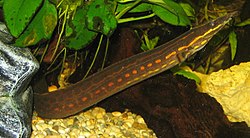| Mastacembelus | |
|---|---|
 | |
| Mastacembelus moorii | |
| Scientific classification | |
| Kingdom: | Animalia |
| Phylum: | Chordata |
| Class: | Actinopterygii |
| Order: | Synbranchiformes |
| Family: | Mastacembelidae |
| Genus: | Mastacembelus Scopoli, 1777 |
| Type species | |
| Ophidium mastacembelus J. Banks & Solander, 1794 [1] | |
| Species | |
See text | |
| Synonyms | |
Mastacembelus is a genus of many species of spiny eel fish from the family Mastacembelidae. They are native to Africa (c. 45 species) and Asia (c. 15 species). [4] Most are found in rivers and associated systems (even in rapids [5] ), but there are also species in other freshwater habitats and a particularly rich radiation is found in the Lake Tanganyika basin with 15 species (14 endemic). [6] [7] A few species can even occur in brackish water. [8]




